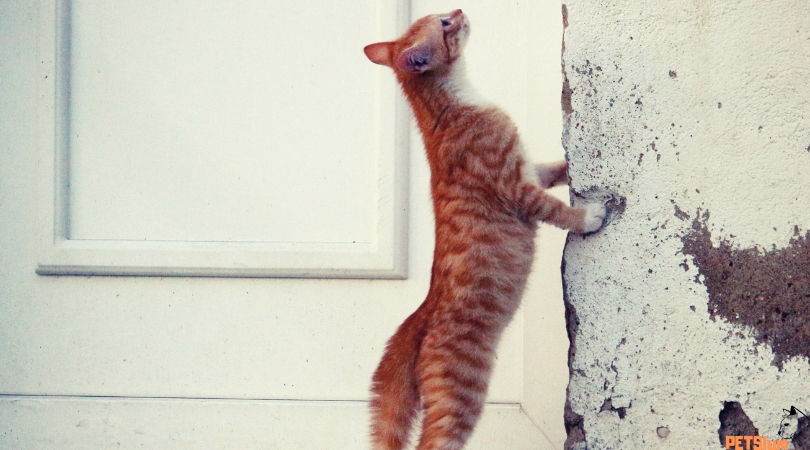If you are the proud owner of a cat, you already know about the beauty of the species’ demeanor and elegant nature. Because cats retain much of their evolutionary ancestors’ instincts and dispositions, many owners are faced with cat behavior problems. Many cat owners find themselves baffled by their furry friends’ actions and are constantly in search of ways to correct their destructive or undesirable behavior.
However, most will try to implement corrective action without taking the vital first step of understanding cat behavior. Obviously, being aware of cat behaviors and what they mean is critical in keeping your feline companion under control.
Post Navigation
Common Cat Behavior Problems
Climbing is among the biggest complaints of all cat behavior problems. Part of the allure of domesticated cats is the primal demeanor inherited from their wild (and much larger) ancestors. That being the case, cats love to perch on high and intently observe the world around them. Unfortunately, this instinct may come at a cost to your household.
Whether it be scratching furniture, picking up dust and dander, or knocking over fragile objects, your cat can do some serious damage en route to their lofty hideout.
The most effective way to prevent climbing is to eliminate access. Try spacing your cat’s launch platform further from their desired spot. Alternatively, you can block their path with furniture, heavy pots or vases, or anything else which blinds their approach. Remember, if your cat cannot clearly see their path and their landing point, they will usually not attempt their climb.
Understanding cat behavior also invariably turns to scratching. Scratching is another primal instinct in cats which is completely natural. Still, you simply cannot afford to have your furniture shredded to pieces, and of the many cat behavior problems owners encounter, this is often the most important one to correct.
Try placing a scratching post in the vicinity of your feline’s habitual scratching area. Rub the post with catnip, or play games with your kitty near the post and reward them when they use it. Scratching is a instinctive activity used to mark territory, so once you get your cat acclimated to using the scratching post, your furry pal should head back for more.

Cat Litter Behavior Problems
Another one of the significant cat behavior problems is inability to use the litter box. House training is a critical step in raising your feline, and doing so can make life much easier on both of you. Here again, understanding cat behaviors and what they mean is crucial. Cats relieve themselves in areas which they are comfortable.
If you are having trouble getting your feline to use the litter box, try relocating it to an area they are fond of soiling. Alternatively, you could put the litter box in a quieter or more secluded area. Like humans, your cat needs a degree of privacy. Having the litter box in a loud or highly trafficked area may discourage your cat from using it.
Although common, cat behavior problems do not have to ruin your home or your relationship with your feline companion. Understanding cat behavior is the most important thing an owner can do, as this knowledge can make correction much easier. Always remember to stay determined and disciplined. With a little bit of effort, your cat will be much easier on your household, allowing you to enjoy their friendship to the fullest extent possible.
Cat Behavior Training
There many reasons why you need to practice cat behavior training. Some of the issues with cat behavior might be urinating outside of the litter box, sharpening their claws where they are not suppose to, climbing planters or curtains, biting, spraying or jumping on tables and counters.
These are all issues that will require behavior training as early as possible. As soon as you see the problem develop, you need to correct the problem before the cat becomes accustom to doing it all the time. Cats are like people, if they are allowed to do something more than once without punishment, they will continue to do it.
Once a cat develops behavior problems, you need to start teaching them some cat training to correct the problem. If your cat uses your furniture or walls to sharpen their claws, you are going to need a cat scratching post where you can take them when you catch them scratching somewhere they are not suppose too.
Importance of Early Cats Training
The earlier you teach them the proper place to scratch, the better they will learn. Consistency is vital when cat behavior training is involved. They can be stubborn if they have been allowed to do something for a long time.

Curtain climbers will need an alternative to curtains. A cat condominium will give your cat somewhere else to climb instead of the curtains or plant hangers. Cat training for this problem will more than likely start as soon as you bring home the new kitty.
Kittens are adorable, but as you know, they can be a handful. They are mischievous and love to climb and explore. With the proper cat training, you can teach them right from wrong. You will find that training the kitten or an older cat will be a challenge that you have to stick with to work.
Cat training might also include teaching the cat to stay off counters. This means, you cannot allow them on the counter sometimes and not at other times. You have to be consistent when training cats. If you give them the upper hand, they will take every inch.
They are the cutest things around, but they are independent as well. They will wait for you to leave the room and try it again. Cat behavior training can be accomplished, you just need determination and a little time to train them in order to see results.
Cat Urine Issues
Cat urine issues are a very common and very frustrating experience for the cat owner. Cat urine issues come in many forms, with different solutions.
Medical Causes of Cat Urine Issues:
Some urine problems have to do not with behavior, but with feline urinary tract infections or feline lower urinary tract disease. Common signs of these an increase in the frequency of urinary or painful urination, possibly with some blood.
Male tom cats are prone to have their urethras plugged with mucus or stones, in which case this is a life threatening emergency which you should see your vet right away.

Behavioral Causes of Cat Urine Issues:
The cat doesn’t like the litter box position, size, odor, etc. If it is one of these causes then you need to take the appropriate steps to alleviate them. Possible solution: Move the litter box, clean the litter box more frequently, place more litter boxes, or get a larger litter box.
Some cats have more anxiety than others which is another reason some cats don’t use the litter box. These could be due to a change in the household routine, a new baby, a new house guest, or a new house. Possible solutions: isolate the cat for a few days, or use Feliway.
Some cats like to mark their territory which is called marking or spraying. Although mostly intact cats to this even neutered cats can do this. Possible solutions: Have your cat neutered, use feliway to help calm them, or block the bottom of screen doors or windows to avoid them seeing other cats.
Training Your Cat to Use the Litter Box
One of the more challenging parts about pet ownership can be those first few weeks and months when you’re trying to potty train your animal. One thing to keep in mind with cat litter box training is that positive reinforcement is the best approach possible. Every time your animal successfully uses the little box, reward him with a treat or some positive attention.
Also keep in mind that you’ll have to be flexible as well. For example, if your cat is having a particularly tough time getting trained, maybe it’s not the cat’s fault.
Try changing out the litter for something that more closely replicates sand or soft dirt. This usually has a higher success rate than hard clay options. Also, use common sense. Make sure the box is cleaned regularly. If the box is full of waste or it smells unpleasant, your cat is less likely to use that box. And never use harsh chemicals or antiseptics to clean the box itself. These can also have harsh smells that will turn your cat away.





